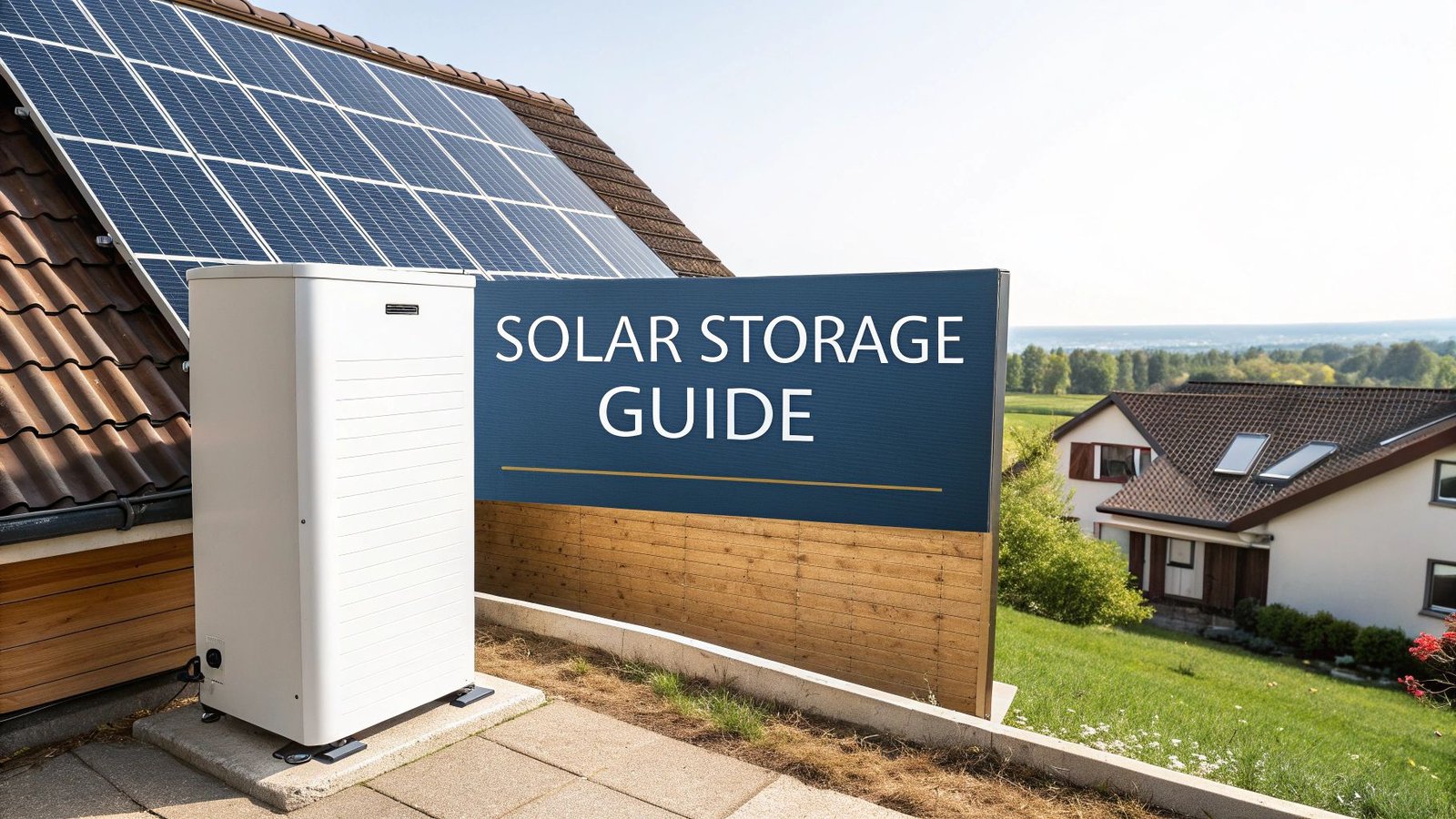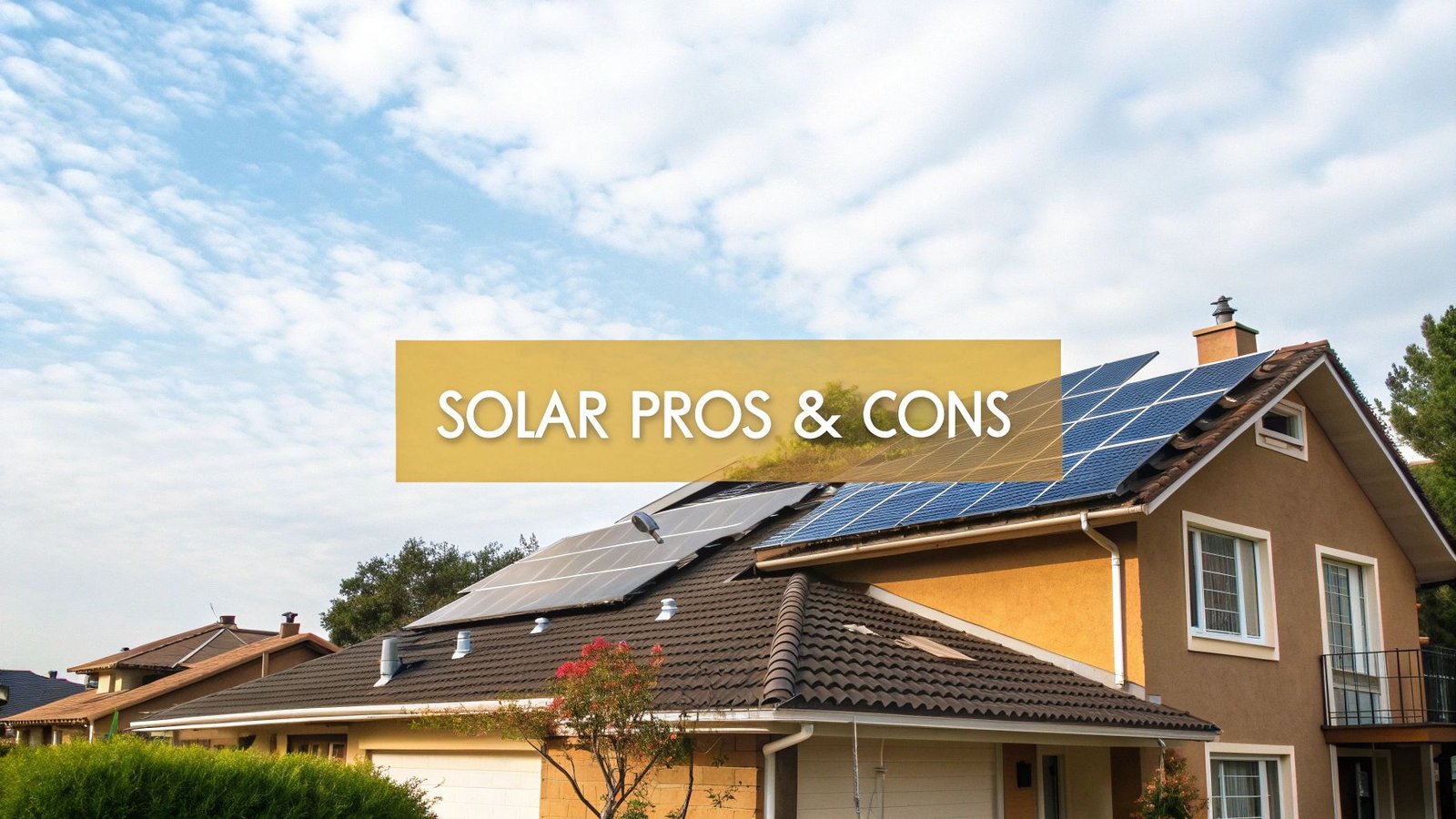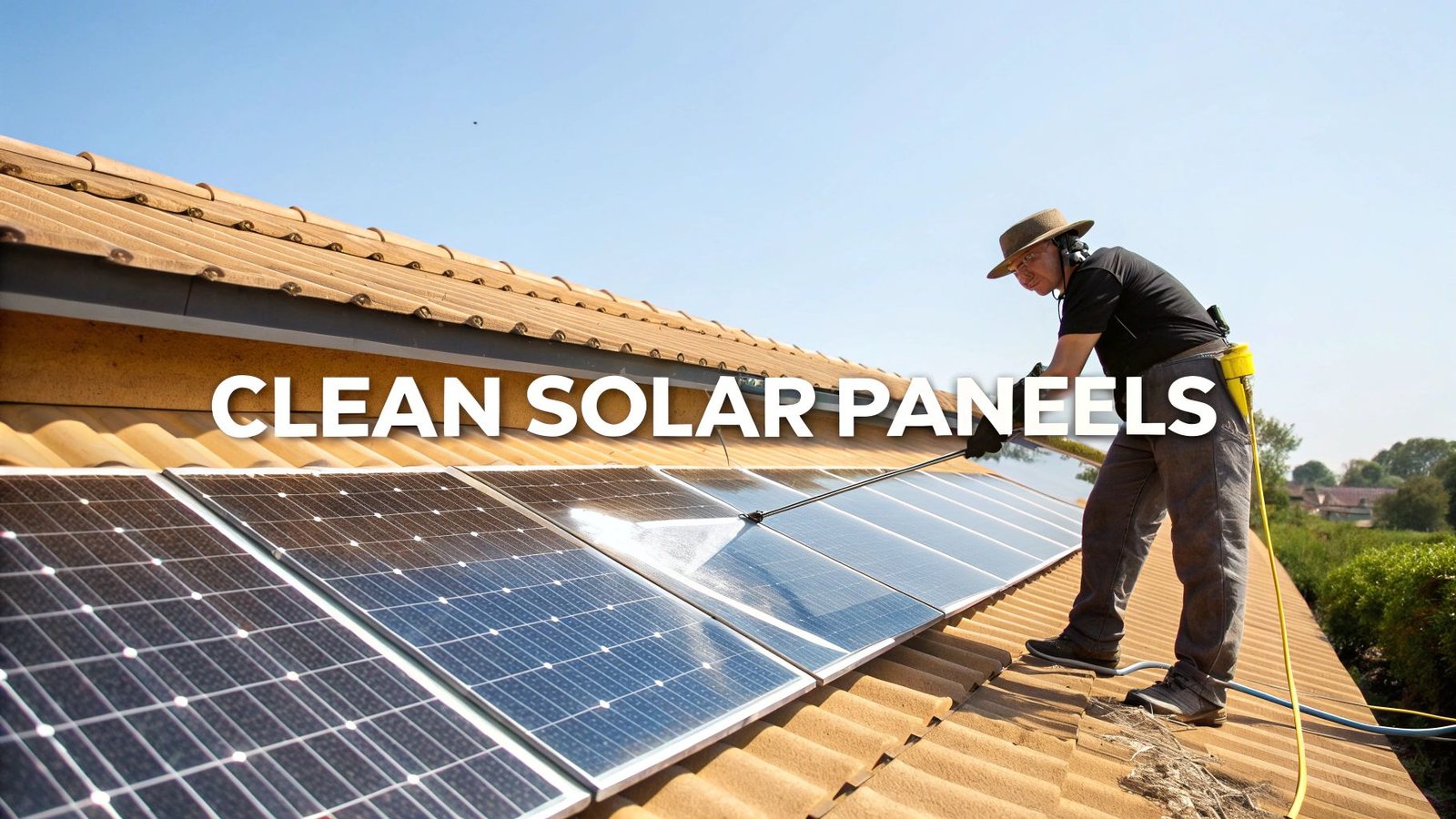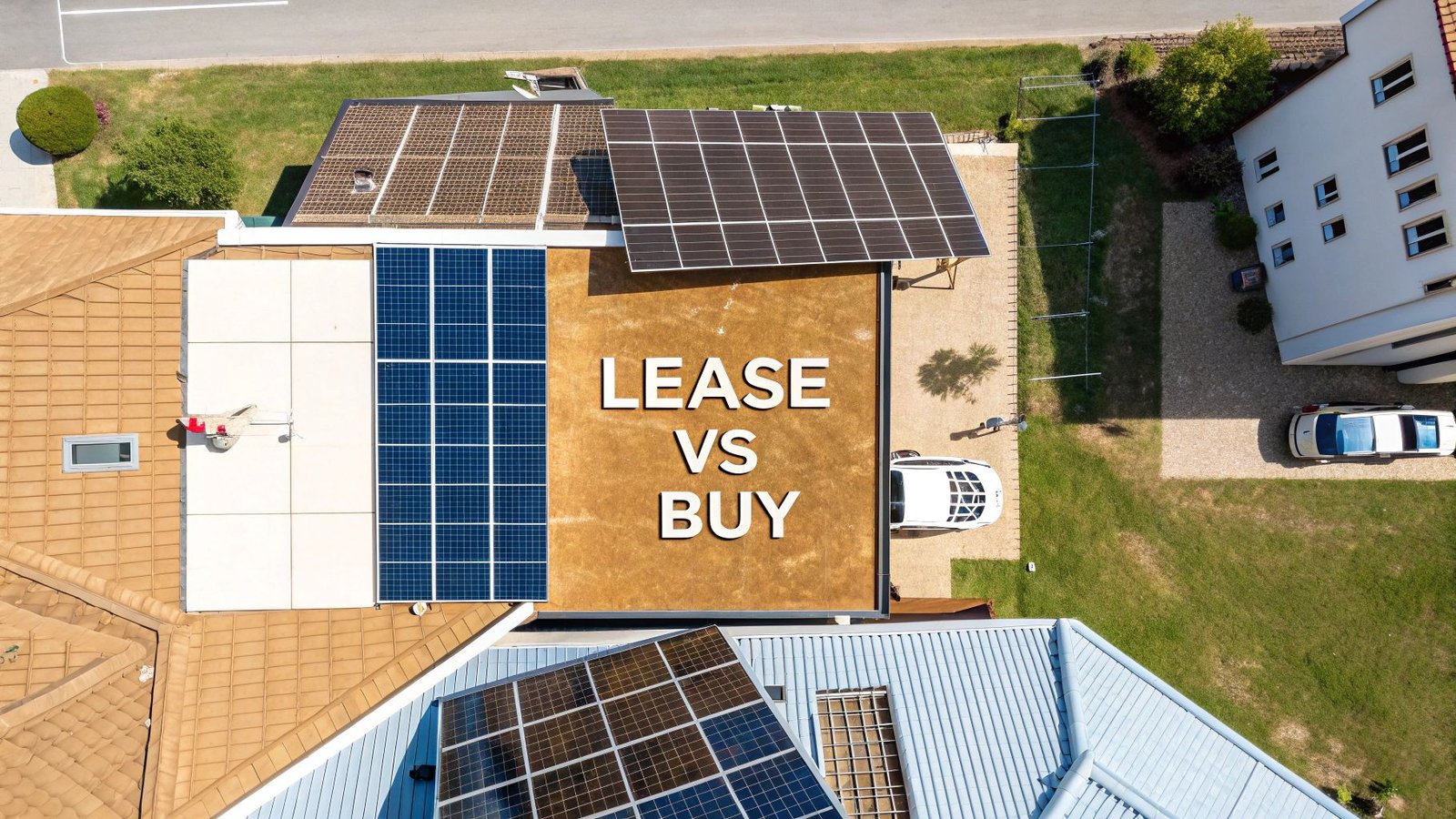Think of solar energy storage as your own personal power reservoir. It’s a system designed to capture all the extra electricity your solar panels produce during the sunniest parts of the day, saving it so you can use it later. This technology, most often a battery, is what lets you run your home at night, during a blackout, or on those dreary, overcast days.
It’s the key to solving solar's main drawback—intermittency—and achieving real energy independence.
Unlocking Solar Power Around the Clock
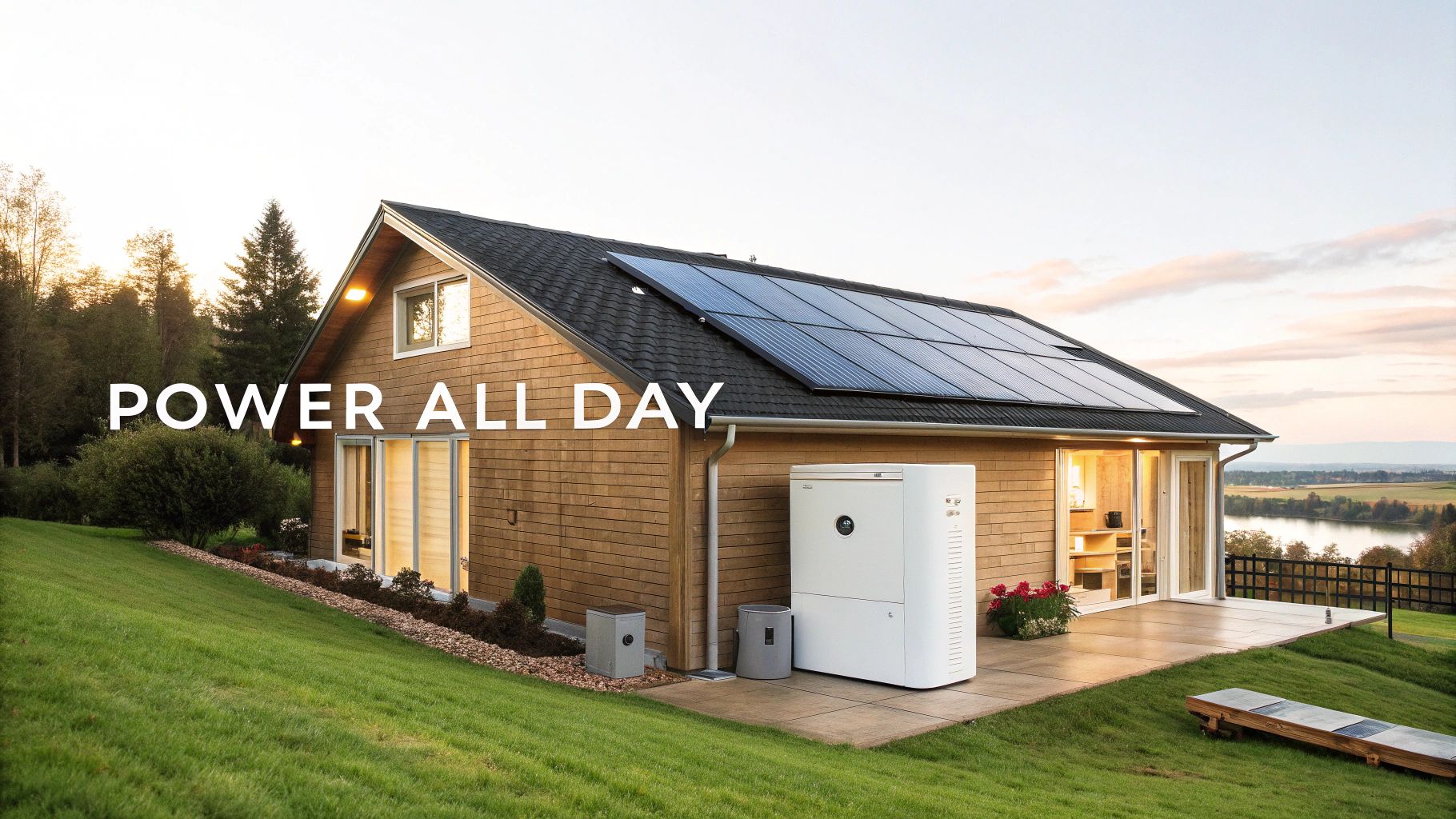
Here's a simple way to picture it: your solar panels are like a super-efficient bucket brigade, but they only work when the sun is out. In the middle of a bright afternoon, they're collecting far more power than your home needs. Without a place to store it, that extra energy goes to waste or gets sent back to the grid.
But what happens when the sun goes down? The brigade stops. That's where a solar battery comes in. It acts as a large tank, collecting and holding all the overflow from those peak sunshine hours.
This stored energy is then yours to command, ready to be used exactly when you need it.
Why Storing Solar Energy Is a Game Changer
Adding storage completely transforms your relationship with solar power. You go from simply generating energy to actively managing it. This control is what makes a battery system such a powerful upgrade for any homeowner with solar panels.
The biggest wins include:
- Energy Independence: You can drastically reduce how much you lean on the utility company, giving you a stable power supply even when the grid goes down.
- 24/7 Solar Power: Use the clean energy you made all day to power your home all night. You can learn more about how this works by reading our guide on how solar panels work at night.
- Cost Savings: Why buy expensive electricity from the grid during peak evening hours when you can just use your own stored energy for free?
This desire for control is driving huge growth. The global market for solar energy storage was recently valued at around USD 93.4 billion and is expected to climb to USD 378.5 billion by 2034. It's a clear signal that homeowners everywhere are seeking more resilience.
Putting You in Control of Your Power
At the end of the day, a solar battery system puts you in the driver's seat. It keeps the lights on during an emergency, shaves money off your utility bills, and helps you get every ounce of value from your solar panels. By storing the sun's energy, you turn an intermittent source into a reliable, 24/7 resource for your home.
To get the absolute most from your system, it’s a great idea to pair your solar storage with some essential home energy efficiency tips. This way, you’re not just making and storing power, but also using it as smartly as possible.
Choosing The Right Battery Chemistry For Your Home
Stepping into the world of solar batteries can feel a little overwhelming at first. There's a lot of new terminology to learn, but when it comes to the core of the system—the battery itself—it really comes down to two main technologies for home use: Lithium-Ion and Lead-Acid.
Understanding the fundamental differences between them is the key to making a smart investment.
Think of it like this: a modern Lithium-Ion battery is like the one in your smartphone. It's compact, charges up fast, packs a powerful punch, and is built to handle the daily grind for years. On the flip side, a Lead-Acid battery is more like a classic car battery. It’s a reliable, heavy-duty workhorse with a proven track record and a smaller price tag, but it's much bulkier and won't last nearly as long.
Key Metrics That Really Matter
To properly compare these batteries, you need to look past the brand names and get down to the numbers that dictate real-world performance. These metrics tell you how much value you'll actually get from your system over its lifetime.
Three of the most important factors are:
- Lifespan (Cycle Life): This is the number of times a battery can be fully charged and discharged before its ability to hold a charge starts to fade. A higher cycle life means a longer-lasting investment.
- Depth of Discharge (DoD): This tells you how much of the battery's total capacity you can safely use without damaging it. A higher DoD means you get to use more of the energy you've stored.
- Round-Trip Efficiency: This measures how much energy you get back out for every unit you put in. Higher efficiency means less energy is wasted as heat during charging and discharging.
These three specs directly shape both the daily performance of your system and its long-term financial payoff.
Comparing Lithium-Ion And Lead-Acid Batteries
So, how do these two battery types actually stack up?
Lithium-Ion batteries, especially the Lithium Iron Phosphate (LFP) kind common in home energy storage, are the clear front-runners in almost every performance category. They boast a Depth of Discharge (DoD) of 80-100%, meaning you can use virtually all of the energy stored inside.
Their lifespan is just as impressive, often rated for more than 5,000 cycles. That translates to a battery that can last 10 to 15 years or even longer, making it a fantastic workhorse for daily use to maximize the solar energy you generate.
On the other hand, traditional Lead-Acid batteries have a much more limited recommended DoD, typically around 50%. Draining them any further can cause permanent damage and shorten their already limited lifespan, which usually lands somewhere between 500 and 1,500 cycles. This makes them a better fit for occasional backup power, not constant daily use.
For people living completely off-the-grid, where durability and a high cycle count are non-negotiable, it's crucial to explore the best batteries for off-grid living.
The classic trade-off here has always been cost versus performance. While Lead-Acid batteries have a lower initial price tag, their shorter lifespan and lower efficiency often result in a higher total cost of ownership over time.
To really see the difference, it helps to put the key specs side-by-side.
Comparison of Solar Battery Technologies
This table breaks down how the most common solar battery technologies compare across the most important metrics, from performance to cost.
| Battery Type | Typical Lifespan (Cycles) | Depth of Discharge (DoD) | Round-Trip Efficiency | Upfront Cost | Best For |
|---|---|---|---|---|---|
| Lithium-Ion (LFP) | 5,000 – 10,000 | 80% – 100% | 90% – 98% | Higher | Daily use, maximizing solar self-consumption, and long-term value. |
| Lead-Acid | 500 – 1,500 | 50% | 75% – 85% | Lower | Low-cost emergency backup power and systems with infrequent use. |
As you can see, the numbers tell a pretty clear story.
Ultimately, the right battery for you comes down to your goals. If you're looking for a dependable, long-lasting, and highly efficient system to get the most out of your solar panels every single day, Lithium-Ion is the way to go. But if your main concern is having a simple, low-cost backup for occasional power outages, Lead-Acid can still get the job done.
How to Correctly Size Your Solar Storage System
Figuring out the right size for your solar battery is probably the most important decision you'll make when designing your system. It's a classic Goldilocks problem. If you go too small, you'll run out of juice and be right back to pulling from the grid when you need it most. Go too big, and you've just paid a premium for storage capacity that will sit there unused.
I like to think of a solar battery like a water tank for your house. The battery's capacity, measured in kilowatt-hours (kWh), is how big your tank is—it tells you how much energy you can squirrel away. Then you have the power rating, measured in kilowatts (kW), which is like the flow rate from your faucet. This number tells you how much electricity the battery can push out at any given moment to run your appliances.
Nailing both of these numbers is the key to designing a system that fits your home and energy goals like a glove.
Start With Your Energy Consumption
First things first, you need to get a handle on how much electricity you actually use. The easiest way to do this is to grab your last few utility bills. Buried in there, you'll find your average daily or monthly usage, almost always listed in kWh.
Let's say your bill shows you used 900 kWh last month. A quick bit of math (900 kWh / 30 days) tells you that your average daily usage is about 30 kWh. This is your baseline, your starting point. It’s the total amount of energy your home needs to get through a typical day.
This simple calculation gives you a solid idea of how large your "energy reservoir" needs to be.
Identify Your Backup Power Needs
Next up, you need to decide what you want this battery to do. Are you looking to keep a few essentials running during a blackout, or are you aiming to tell the utility company goodbye for good? Your answer here will have a huge impact on the size of the system you need.
Take a minute and list out the absolute must-haves you can't live without during an outage:
- Refrigerator and Freezer: This is usually at the top of everyone's list to avoid spoiled food.
- Lights: A few key lights in the kitchen, bathrooms, and hallways are essential.
- Medical Equipment: If you have any necessary medical devices, they are non-negotiable.
- Well Pump: For those on well water, keeping the pump active is critical.
- Internet Router: In today's world, staying connected is often a top priority.
Every appliance has a power rating (in watts) and an estimated daily run time. Tallying these up gives you a very clear picture of the minimum capacity and power rating your battery needs to handle your essential loads. For a more detailed look, our guide on how to store solar energy offers more context on matching storage to your lifestyle.
The infographic below breaks down the key decision points when you're looking at different solar energy storage options.

This visual guide helps simplify the choice by laying out the main features of the most common battery technologies available today.
Define Your Primary Energy Goal
Beyond just having backup power, what’s the real reason you want a solar battery? Your long-term motivation is a huge piece of the sizing puzzle.
-
Goal 1: Maximize Self-Consumption: If your main goal is to use as much of your own clean energy as possible and minimize what you buy from the utility, you’ll need a battery big enough to store your excess solar power from the day to cover your needs through the evening and night. A battery sized close to your average daily consumption (say, 15-30 kWh) is often the sweet spot.
-
Goal 2: Achieve Energy Independence: If you're dreaming of going completely off-grid (or close to it), you're going to need a much beefier system. This means having enough storage to power your entire home for several days in a row without any sun, just in case you hit a long stretch of cloudy weather. These systems are a significant investment in both size and cost.
By clearly defining your goals—whether it’s saving money, ensuring backup power, or reducing your carbon footprint—you can have a much more productive conversation with a solar installer. This clarity ensures you invest in a system that is perfectly sized for your specific needs, not someone else's.
This kind of careful planning is becoming more important than ever. Total installed solar capacity recently hit 2.2 TWdc, which is a massive amount of power generation. As this number grows, pairing those panels with correctly sized batteries is the only way to effectively store that excess energy and use it when demand is highest. You can read the full report on solar capacity growth from NREL.
By taking the time to analyze your usage, pinpoint your critical loads, and clarify your goals, you can move forward with confidence and choose the perfect size for your solar storage solution.
Understanding the True Cost of Solar Storage
The sticker price on a solar battery can be misleading. While it’s the number everyone focuses on, it only tells a fraction of the story. To really get a handle on the investment, you need to think in terms of a complete solar energy storage solution. This means factoring in not just the battery, but every component and service needed to get it humming along safely in your home.
It’s a bit like buying a high-performance engine for a car. The engine is the star of the show, but it’s just a heavy piece of metal without a transmission, a cooling system, and an expert mechanic to install it. A solar storage system is no different; a few key costs come together to make up the final price tag.
Breaking Down the Total System Cost
When you get a quote for a solar storage project, you're looking at the sum of its parts. Sure, the battery is the single biggest line item, but things like the inverter, labor, and permits add up to a serious chunk of the total. Seeing this breakdown helps you understand exactly where your money is going.
Generally, the costs fall into four main buckets:
- The Battery: This is the heart of your system. Expect it to be the largest share of the cost, often around 50-60% of the total.
- The Inverter: Think of this as the system's brain, directing the flow of energy. It can represent 10-20% of your budget.
- Installation & Labor: You're paying for the expertise of certified installers and electricians to ensure a safe, efficient setup. This typically makes up another 10-20%.
- Other Costs (Permits, BOS): This catch-all category includes necessary permits, wiring, mounting hardware, and other Balance of System (BOS) parts, usually accounting for the last 10-15%.
Here’s a simple visual to show you how that all adds up.
As you can see, almost half of your investment goes toward components and skilled labor that aren't the battery itself.
The Long-Term Value: Levelized Cost of Storage
To move past the upfront price and see the real, long-term value, pros look at the Levelized Cost of Storage (LCOS). This metric essentially boils everything down to a single, powerful number: the cost per kilowatt-hour (kWh) the battery will provide over its entire life. It’s the best way to make a true apples-to-apples comparison between different systems.
LCOS flips the script on how we think about cost. A battery with a higher upfront price but a much longer lifespan and better performance can actually have a lower LCOS, making it the smarter financial choice over time.
This is exactly why a seemingly "cheaper" battery with a short lifespan can end up costing you more. It simply delivers less energy over its lifetime, which drives up the cost for every single kWh you pull from it.
Financial Incentives That Lower the Barrier
The good news? You don't have to foot the entire bill yourself. A whole host of financial incentives exist to make solar storage more accessible for homeowners. Tapping into these programs can dramatically cut your initial investment and speed up your payback period.
The biggest one out there is the Federal Solar Investment Tax Credit (ITC). This incentive lets you claim a credit for 30% of the total cost of your solar and storage system. It's not a deduction; it’s a direct, dollar-for-dollar reduction in what you owe in federal taxes.
But it doesn't stop there. Many states and even local utility companies have their own programs. Keep an eye out for:
- State-Level Rebates: Many states will give you cash back, which can slice thousands of dollars right off the top.
- Utility Programs: Some electric companies offer their own incentives or special rates for customers who install batteries, as it helps them stabilize the grid during peak hours.
By "stacking" these federal, state, and local incentives, you can seriously reduce the net cost of your system, turning a smart decision into an absolute no-brainer.
How Storage Integrates with Your Solar Panels
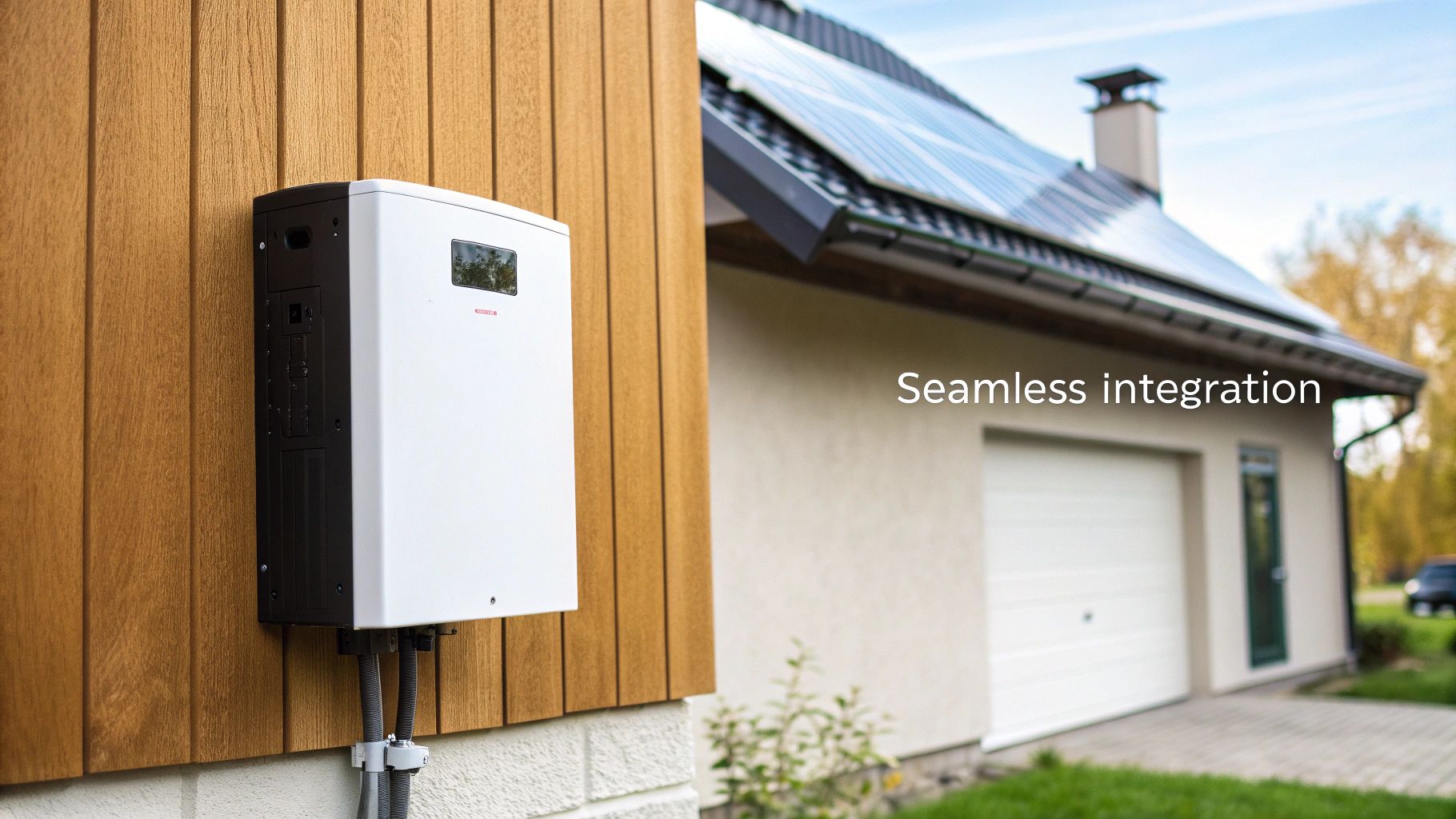
So, how do you actually connect a battery to your solar panels? It's not quite as simple as plugging it into the wall. There are two main ways to integrate these powerful solar energy storage solutions into your home: AC coupling and DC coupling. Getting your head around the difference is the first step to designing a system that’s efficient and built for your specific needs.
Here's the core concept: your solar panels generate Direct Current (DC) electricity, but your home's appliances run on Alternating Current (AC). Your battery, like the panels, stores energy as DC. How your system handles the conversion between these two types of power is what separates an AC-coupled setup from a DC-coupled one.
DC Coupling: The Direct Pipeline
Think of a DC-coupled system as a direct, highly efficient pipeline. The DC power flows straight from your solar panels into a smart device called a hybrid inverter. This single piece of hardware is the brains of the operation, deciding where that power should go—either directly into your battery for storage or converted into AC for immediate use in your home.
This setup is incredibly efficient because the energy only has to be converted from DC to AC once, right when it's needed. This direct path minimizes energy loss along the way, making it a fantastic choice for brand-new solar-plus-storage installations where you want to squeeze every last watt out of your panels.
AC Coupling: The Flexible Adapter
An AC-coupled system, on the other hand, is more like a universal adapter. It's wonderfully flexible, which makes it the go-to method for adding a battery to a solar panel system that's already up and running.
In this configuration, your solar panels are already hooked up to their own inverter that converts DC power to AC for your home. To add storage, you simply install a second inverter specifically for the battery. This means the AC power from your solar inverter gets converted back to DC to be stored. While this double conversion leads to slightly lower efficiency, its adaptability is perfect for retrofitting storage without overhauling your entire setup.
Of course, to keep your storage system fed with power, your panels need to be performing at their best. Keeping them clean is crucial, and you might even consider professional solar panel cleaning services to maximize your energy generation.
The Hybrid Inverter: Your System's Traffic Controller
In both configurations, the inverter is the heart of the system. In DC-coupled setups, a hybrid inverter plays an especially critical role, acting as the central traffic controller for all the energy flowing through your home.
It’s a sophisticated piece of tech that intelligently manages electricity from multiple sources, making instant decisions to optimize your power usage. A hybrid inverter can:
- Send surplus solar power to charge your battery.
- Draw stored power from the battery to run your home at night.
- Route solar power directly to your appliances during the day.
- Sell excess energy back to the grid (if you choose to).
This seamless integration is what makes modern solar storage so powerful. The hybrid inverter ensures that you are always using the most cost-effective and efficient energy source available, whether it's from your panels, your battery, or the grid, without you ever having to lift a finger.
This technology is a huge reason why the global solar storage market is booming. The Asia-Pacific region currently leads the pack, with systems in the 2,501 KW to 5,000 KW range being especially common for commercial and industrial applications, making up about 35% of the total market.
Got Questions About Solar Storage? We've Got Answers.
When you start digging into solar energy storage, it's natural for a few questions to pop up. Making a smart investment means getting clear answers, so you can feel confident about how this technology will work for you and your home. Let's tackle some of the most common questions we hear from homeowners.
How Long Do Solar Batteries Last?
You can look at a solar battery's lifespan in two ways: its warranty and its cycle life. Today, most top-tier lithium-ion batteries come with a solid 10 to 15-year warranty. This is the manufacturer's promise that your battery will hold at least 70% of its original capacity by the end of that period.
But the real-world lifespan is often even longer. This is where "cycle life" comes in—it's the number of times a battery can be fully charged and discharged before it starts to lose a noticeable amount of capacity. A quality system gives you 5,000 to 10,000 cycles, which translates to well over a decade of dependable, daily power. Just keep in mind that things like extreme temperatures or how deeply you drain it can play a role in its overall longevity.
Can I Go Completely Off-Grid with Solar and Storage?
While the idea of total energy independence is tempting, going completely off-grid is a major commitment. It’s technically possible, but it means sizing up your whole system—more panels and a much larger battery bank—to ensure you can power everything through several cloudy days in a row.
For most people, a grid-tied system with battery backup is the sweet spot. It offers the best of both worlds:
- Reliability: You still have the grid to fall back on during long stretches of bad weather.
- Cost-Effectiveness: The system is significantly smaller and more affordable than what's needed for a full off-grid setup.
- Peace of Mind: You get the energy security you want during an outage without the massive cost and complexity of cutting ties with your utility for good.
What Maintenance Do Solar Batteries Require?
Here's some great news: modern lithium-ion solar energy storage solutions are practically maintenance-free. These smart systems are built with an internal Battery Management System (BMS), which is essentially the battery's brain. It constantly monitors everything to keep it running smoothly and efficiently.
The BMS is always working behind the scenes, balancing the charge between cells and protecting the battery from things like overcharging or getting too hot. This built-in intelligence means you don't have to fuss with the kind of hands-on upkeep that older lead-acid batteries required.
Really, all you might need to do is give it a quick visual check a couple of times a year to make sure the vents are clear. Your installer will give you the full rundown for your specific model.
How Does a Solar Battery Work During a Power Outage?
The moment the power goes out, your system kicks in automatically. A device called an automatic transfer switch instantly senses the grid failure and disconnects your home from the utility lines for safety. At the same time, it tells your system to start pulling power from your battery.
The switchover is so fast and smooth, you probably won't even see the lights flicker. Your battery will immediately start powering the circuits you’ve chosen as essential—things like your refrigerator, lights, internet, and any medical equipment. It keeps your home running safely and comfortably, right when you need it most.
Ready to take control of your home's energy? At Radiant Energy, we design and install high-quality solar energy storage solutions built to last. Contact us today for a free quote and discover how you can achieve energy independence.

